To Build, or Not to Build…?
Generally, the answer is: Don't build IT solutions that exist in the marketplace. Use your top talent to build what others cannot.

Generally, the answer is: Don't build IT solutions that exist in the marketplace. Use your top talent to build what others cannot.

Get Involved
Our authors are what set Insurance Thought Leadership apart.
|
Partner with us
We’d love to talk to you about how we can improve your marketing ROI.
|

Bobbie Shrivastav is founder and managing principal of Solvrays.
Previously, she was co-founder and CEO of Docsmore, where she introduced an interactive, workflow-driven document management solution to optimize operations. She then co-founded Benekiva, where, as COO, she spearheaded initiatives to improve efficiency and customer engagement in life insurance.
She co-hosts the Insurance Sync podcast with Laurel Jordan, where they explore industry trends and innovations. She is co-author of the book series "Momentum: Makers and Builders" with Renu Ann Joseph.
Technological leaps will range from responsive mobile websites and texting with customers to chatbots and voice searches.

Get Involved
Our authors are what set Insurance Thought Leadership apart.
|
Partner with us
We’d love to talk to you about how we can improve your marketing ROI.
|

Jason Walker is managing partner of Smart Harbor, focused on two goals: helping independent insurance agents realize growth using digital technologies and enabling carriers to develop deeper partnerships and greater insights into the performance of their agent distribution channels.
Buyers and sellers all gain by being able to transact leads using a single, trusted currency; it creates valuable consumer experiences.

Get Involved
Our authors are what set Insurance Thought Leadership apart.
|
Partner with us
We’d love to talk to you about how we can improve your marketing ROI.
|

Jaimie Pickles is co-founder and CEO at First Interpreter.
He was previously general manager, insurance, at Jornaya, which analyzes consumer leads for insurance and other industries. Before that, he was president and founder of Canal Partner, a digital advertising technology company, and president of InsWeb, an online insurance marketplace.
Call me a cynic, but here’s my bold customer experience prediction for most companies in the coming year: Not much will change.

Get Involved
Our authors are what set Insurance Thought Leadership apart.
|
Partner with us
We’d love to talk to you about how we can improve your marketing ROI.
|

Jon Picoult is the founder of Watermark Consulting, a customer experience advisory firm specializing in the financial services industry. Picoult has worked with thousands of executives, helping some of the world's foremost brands capitalize on the power of loyalty -- both in the marketplace and in the workplace.
The State Farm chatbot ad has been criticized, but it is great to finally see a large insurer that is proud of its agents.

Get Involved
Our authors are what set Insurance Thought Leadership apart.
|
Partner with us
We’d love to talk to you about how we can improve your marketing ROI.
|

Matteo Carbone is founder and director of the Connected Insurance Observatory and a global insurtech thought leader. He is an author and public speaker who is internationally recognized as an insurance industry strategist with a specialization in innovation.

Steve Anderson is a seasoned business and technology veteran speaking on using technology in practical ways that will actually improve profits.
The discussion on blockchain needs to be fully integrated within the context of existing and anticipated regulatory compliance requirements.

The past several months have seen increased activity and focus on the promising technology of blockchain and its potential in the insurance industry. Blockchain has also reemerged as an important issue in the European Union (EU) following the go-live date of the General Data Protection Regulation (GDPR) on May 25 of this year. As a side note to U.S. policymakers, including the California legislature, the GDPR was adopted two years before its effective date. There was a reason for that.
There will be a considerable amount of scrambling in Sacramento this year as efforts are made to clarify the scope and limit the unintended consequences of the hastily enacted California Consumer Protection Act 0f 2018 (CCPA). Virtually everyone in the insurance environment – including startup and established insurtechs – need to keep a very close eye on what emerges during this effort in 2019.
Regardless, it is important for all those dealing with technology to understand how the E.U. is dealing with issues such as blockchain. Businesses in California should be paying particularly close attention to how the E.U. is attempting to reconcile GDPR and emerging technologies while the CCPA is moving inexorably to its effective date of Jan. 1, 2020. Multinational companies are already dealing with GDPR compliance given its long extraterritorial reach. Inevitably, how the E.U. is dealing with privacy will serve as at least a partial template for how privacy issues will be dealt with in the U.S. E.U. commissioners are currently attempting to sort out the interaction between GDPR and blockchain technology. It is not a nice fit.
To foster a dialogue on this issue, the E.U. Blockchain Observatory and Forum was created as a European Parliament pilot project. Per its website, the observatory’s mission is to monitor blockchain initiatives in Europe, produce a comprehensive source of blockchain knowledge, create an attractive and transparent forum for sharing information and opinion and make recommendations on the role the E.U. could play in blockchain.
On Oct. 16 of this year, the E.U. Blockchain Observatory and Forum published a thematic report, “Blockchain and the GDPR.” As noted in the report regarding blockchain and GDPR compliance: “The issue of compliance of blockchain with GDPR is an important one. By specifying how personal data is to be protected, the GDPR will play a fundamental role in shaping digital markets in the Union. Considering its strong support of this nascent technology, the European Union clearly believes that blockchain technology has an equally important role in these markets, too, offering new paradigms for the ways we transact and interact with each other.” (Report, p.8)
See also: Blockchain’s Future in Insurance
What is not clear at this point in time is how blockchain can flourish while remaining compliant with GDPR. There are those who think the fundamental structure of blockchain is irreconcilable with GDPR. That opinion is not prevailing at this time.
As noted repeatedly in the report, GDPR compliance is not about the technology, it is about how the technology is used. There are clearly issues, even with private consortium blockchains, that need to be fully understood. The issue isn’t just where the data are housed, the issues also include who controls the data and, as the report repeatedly emphasizes, how that data are used.
The E.U. is ahead of the U.S. in efforts to balance the rights of natural persons regarding their own personal information and the improvements that can come from technological innovation. While various sectors of the economy, including insurance, seem to be gushing about the possibilities of blockchain, there is a singular silence about how this environment will comply with the host of state and federal requirements placed on all the participants in this distributed ledger technology.
This isn’t just about privacy in general and the CCPA in particular, although the CCPA could disrupt blockchain even in the commercial context if there is no further clarification during the 2019 California legislative session. The observatory’s report, however, serves as a reminder that the GDPR deals with personally identifiable information belonging to natural persons and not information that is shared with other business forms provided to businesses.
That is an important distinction but not entirely dispositive. In the world of commercial insurance, there are sole proprietors who must have not only liability coverage but also workers’ compensation insurance. These are “natural persons” who under GDPR and currently under the CCPA could ask their personal data to be removed from a database. This is not consistent with the blockchain’s promise of immutable records. (See: Civil Code Sec. 1798.105)
Earlier this year, industry giants Marsh and IBM, working with Acord, teamed up to develop a commercial blockchain for proof of insurance. Acord is the Association for Cooperative Operations Research and Development, an industry-supported organization that, among many other functions, makes many of the forms used in the property and casualty insurance industry for the transaction of insurance (applications, certificates, etc.). The pilot participant for this is ISN, a global contractor and supplier information management business.
Per Marsh’s announcement earlier this year, “A distributed ledger technology, blockchain is ideally suited to large networks of partners. It establishes a shared, immutable record of all the transactions that take place within a network and then enables permissioned parties access to trusted data in real-time.” IBM and Marsh also recently announced that they are working on making the proof of coverage blockchain accessible to Marsh clients through Salesforce. Recently, The Institutes, best known for its professional designation programs in the insurance industry, has launched its RiskBlock Alliance. Per its Sept. 23, 2018 announcement, “…a blockchain consortium representing 31 risk management and insurance companies, has launched Canopy, the industry’s first end-to-end reusable blockchain framework, using the Corda blockchain platform.”
One of the use cases currently being developed for Canopy is proof of insurance. In remarks on the National Association of Insurance Commissioners (NAIC) Innovation and Technology (EX) Task Force Oct. 15, 2018, conference call, Christopher McDaniel, president of RiskBlock Alliance, said, in response to an inquiry from Oregon Division of Financial Regulation Deputy Administrator TK Keen: “…if regulators have their own node on the blockchain, they could push a button and create a report, as long as the appropriate agreements were in place to share the information.” [NAIC Innovation and Technology (EX) Task Force conference call Oct. 15, 2018, draft minutes dated Oct. 26, 2018]
In a July 12, 2018, blog titled “Ultimate Guide to Blockchain in Insurance” from management consulting firm Accenture, it was noted that blockchain would facilitate “using shared loss histories to obtain data-driven insights on prospective customers for more sophisticated pricing.” I suspect that state insurance regulators would have a keen interest in how that would be accomplished.
Workers’ compensation rating organizations such as the National Council on Compensation Insurance, Inc. (NCCI) or the Workers’ Compensation Insurance Rating Bureau of California (WCIRB), operating under license from state insurance regulators and serving as a critical part of the active regulation of insurance required under the McCarran-Ferguson Act, would most likely have a few questions as well. In other words, while there has been much discussion about the promise of blockchain, that discussion needs to be fully integrated into the discussion of how all that data are going to be secured, shared, and stored within the context of existing and anticipated regulatory compliance requirements.
This goes beyond insurance regulation and, as is the case with the EU, directly implicates the emerging and complex privacy environment as evidenced by the CCPA. Take, for example, the issue of proof of coverage and the issuance of certificates of coverage within the workers’ compensation environment. These are two separate issues that require separate solutions. States maintain coverage verification portals for any person to verify workers’ compensation coverage. These are managed by rating organizations pursuant to statutory mandate and generally by self-insurance regulatory authorities. In some instances, such as with California’s Contractors State Licensing Board (CSLB), there are separate coverage disclosure requirements that are also accessible by the general public. This is not a testament to the accuracy of these systems, but rather only to their accessibility.
For blockchain to be effective in the workers’ compensation environment, therefore, it needs to have some degree of integration with public databases. That isn’t as easy as it may seem. For example, Labor Code Sec. 3715 states, “The nonexistence of a record of the employer’s insurance with the Workers’ Compensation Insurance Rating Bureau shall constitute in itself sufficient evidence for a prima facie case that the employer failed to secure the payment of compensation.”
Does this mean that rating organizations should have a node on the proof of coverage blockchain, as should the Division of Labor Standards Enforcement (DLSE) and the Department of Insurance (CDI)? If that is the case, then what does that mean for purposes of public records laws and whether the blocks in the blockchain are public records? In other words, if the blockchain is to serve a public purpose then it must take into account access issues that may not be present when the ledger is entirely for private transactions.
See also: How Insurance and Blockchain Fit
A certificate of insurance is issued, arguably, by either an agent or broker or an insurance company. For most transactions, this is currently done through a writable .pdf document or done manually. This process is an open invitation for fraud. The work Acord is doing with Marsh and The Institutes underscores a technology solution may help make the certification of insurance coverage – both as to existence and to limits (for liability lines of insurance) more reliable and transparent.
This is not an inconsequential matter, especially in California and considering the particular issue of whether some staffing companies are very much part of the problem. The latter issue regarding staffing firms is a critical one for California. Given the Golden State’s broad regulation of employment relationships, it is at best vexatiously ironic that when it comes to staffing agencies, with some very limited exceptions, there is virtually no regulatory framework to verify the legitimacy of staffing firms and the way they do business.
This is a problem – and a problem that needs to be resolved before applying a technology solution to the issue of bogus certificates of insurance. And that finally leads us back to what the observatory noted in its thematic report: “… start with the big picture: how is user value created, how is data used and do you really need blockchain?”
Get Involved
Our authors are what set Insurance Thought Leadership apart.
|
Partner with us
We’d love to talk to you about how we can improve your marketing ROI.
|
A dynamic tool, covering all stages of development, allows for the calibration of a benchmark that better resembles individual portfolios.

No single liability is quite as important to insurers as a best estimate of unpaid claims. It drives earnings reports, shapes financial statements and influences a host of other management decisions. But aberrations in data and model risk often cast a shadow over the reliability of reserve ranges from which this point is selected. Traditional development pattern benchmarks have provided some support in estimating these fundamental liabilities, but, even here, the process has long been a one-dimensional exercise, at least until now.
In determining a central or “best” estimate for property and casualty (P&C) reserves, the goal has never been to zero in on the exact final outcome for an insurer’s ultimate losses but to arrive at an estimate that is as likely to be high as it is to be low. Rather than trying to pinpoint one elusive number, the unpaid claim analysis process has focused on understanding or illustrating the variability around the estimate by identifying a range of reasonable estimates using different methods and assumptions.
By producing other reasonable estimates, actuaries moved somewhat closer to the goal of understanding the full breadth of the possible outcomes, but this approach still lacks specificity and provides little more certainty around an unpaid claim estimate. Commonly used “static” loss development pattern benchmarks that use industry data have been helpful in assessing some of the actuary’s assumptions but not all of them. The lack of specificity in these benchmarks has only marginally improved confidence in the selection of a range and central estimate.
The question is how do you overcome these challenges?
A recently developed dynamic benchmarking tool, which includes percentiles at all stages of development, allows for the calibration of a benchmark that better resembles individual portfolios. As such, this rigorously back-tested tool can provide actuaries an added level of confidence in the reasonableness of any entity’s reserve ranges. This next-generation benchmarking tool, known as claim variability guidelines (CVG), is derived from extensive testing that involved all long-tail Schedule P lines of business and more than 30,000 data triangle sets. Using such an extensive database both:
Four real-life scenarios The value of this new benchmarking tool stems from its ability to guide an actuary’s decision-making process by providing an interactive means of comparing the assumptions or estimates from a method or model based on real data and results against comparable alternative assumptions or estimates. To illustrate the potential impact of using such benchmarks, four representative data sets were used from randomly selected companies of four different sizes: A) small, B) regional, C) small national and D) large national. Minor changes were made to the data to protect the identities of each company. For all four companies, the commercial auto line was selected as a common denominator for contrasting the effect of the guidelines for different exposure sizes. To illustrate how useful the guidelines are in practice, a unique variety of lines of business was sampled for each carrier. The accident year earned premiums by line of business for each company are illustrated in Figure 1.
See also: Provocative View on Future of P&C Claims
Figure 2, which shows the incremental and cumulative loss development patterns for commercial auto for Company A, provides an example of the type of CVG output that actuaries could use to guide their thought processes. In this case, the incremental loss development from the user’s model shows a pattern that initially might seem to be relatively smooth, but when compared with output from an industry average or the guidelines its irregularities become apparent. For this company, whose loss development pattern is somewhat volatile, using a benchmark pattern other than the average (shown in the “CVG Average Pattern” row) seems appropriate. But which one? 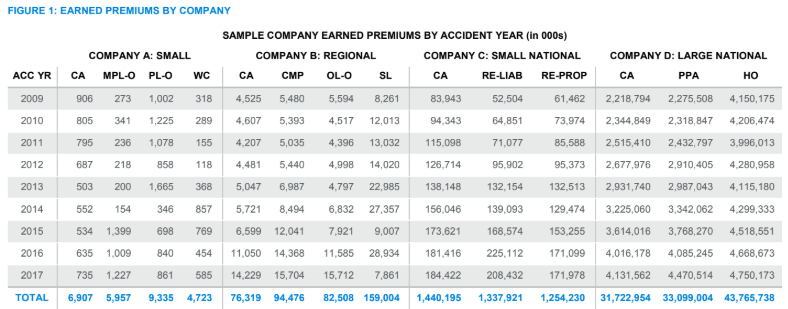
While the guidelines indicate that the 46th percentile (shown in the “Best Fit” row) is the best fit overall, the 46th percentile is less than ideal at different periods, where "best fits" vary from the 13th percentile in development periods 0 to 12 to the 99th percentile in development periods 72 to 108. In fact, there is considerable variability in the recommended fits—a situation that might be expected, considering the data limitations that a small company often encounters. But does the user’s calculated loss development pattern (shown as “User Input ATA Factors” in Figure 2) reflect the company’s uniqueness or contain random noise that could be smoothed by the benchmarks? 

Using the cells in the CVG line, actuaries can select different assumptions and see the impact on their results. Is a dip or bulge in the User Input pattern due to noise, or does it reflect reality? Perhaps the company consistently pays claims faster than the industry average? How different is the mix of business compared with the industry average? Are the User Input Age-to-Age (ATA) factors from 72 to 120 months indicative of salvage and subrogation recoveries that should be included? At any point along the pattern, actuaries can adjust the pattern—using the User Input pattern, the selected guidelines pattern or an alternative—to reflect their understanding of a company’s data. This guided sensitivity testing provides actuaries a way of systematically exploring loss development patterns and deciding how much smoothing is necessary or which pattern is most appropriate. 
As the exposures increase, the volatility of the calculated loss patterns decreases. For example, the commercial auto loss pattern for Company B in Figure 3 now meanders closer to the best-fit pattern, a situation that is reflected in the increased consistency among the best-fit percentiles (“Best Fit” row). In this case, the best fit is at the 71st percentile. As the patterns calculated from the user’s method and the guidelines move closer together, as is the case for this regional company, the justification for selecting a pattern other than the average increases. By comparing the development pattern graphs in Figures 2 and 5, the difference between the loss patterns calculated from the data and the guidelines merge ever closer for the small national company, as seen in Figure 4, and for the large national company the loss patterns nearly overlay the average, in Figure 5. This convergence of the loss development patterns on the average, interestingly enough, also illustrates how the static average-based benchmarks are most relevant for large national companies, how the various percentiles around the average become more valuable as the exposure size decreases and how both large and small companies benefit from the additional information available in a dynamic benchmark. Once an actuary decides on a loss pattern, a range of reasonable estimates can be established by, for example, using patterns 20 points on either side of the selected loss pattern, as illustrated in Figure 6 below (assuming our best fit is at the 46th percentile and the table sets' lower and upper benchmarks are at the 26th and 66th percentiles). 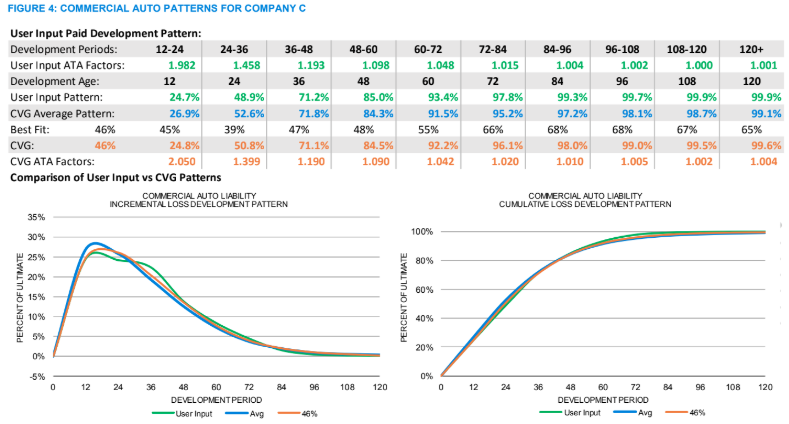
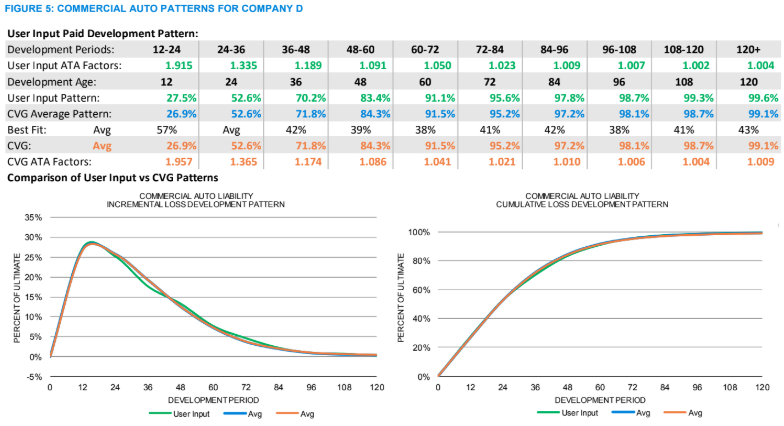
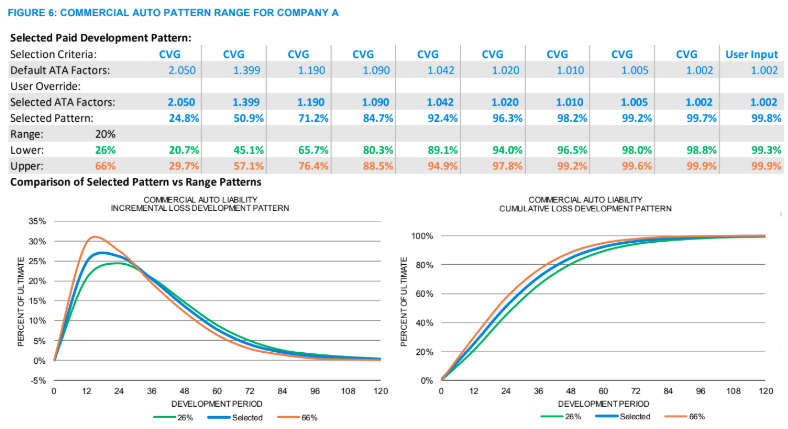
In each of these examples of this next-generation benchmarking process, the estimates for the “normal” weighted results (in Figures 7 and 8 below) were done mechanically using common methods and assumptions to prevent personal biases from masking the potential impact of this process. In practice, this step would be an interactive process, with the guidelines influencing the selection of assumptions and methods and vice versa. For the small company illustrated in Figure 7, the guidelines patterns from Figure 6 are used to estimate unpaid claims to be between 850 and 1,210. This result can be compared with the range and weighted average for the five methods used by the actuary, who now has a supplemental process for deciding on a best estimate. That process includes a new tool for deciding whether any of the estimates in the normal range are unreasonable, e.g., is the lowest estimate in the weighted range reasonable? 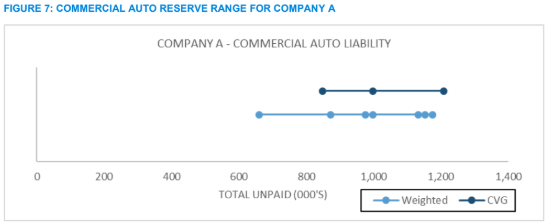
For even the most volatile lines, this process provides a guided method for inquiry and analysis that can lead to greater confidence in the end results. As each line of business is reviewed, they can also be added together to get a view of the overall range for the company, as illustrated in Figure 8.
See also: De-Siloing Data for P&C Insurers
Determining a range of reasonable estimates and a best estimate are fundamental building blocks for assessing the financial health of a company, but they are only a small part of a claim variability process. From benchmarking unpaid claim distributions to setting risk-based capital requirements—topics of subsequent articles in this series—the next generation of benchmarks can help actuaries retool their methods of inquiry and build confidence in the numbers shared with management. 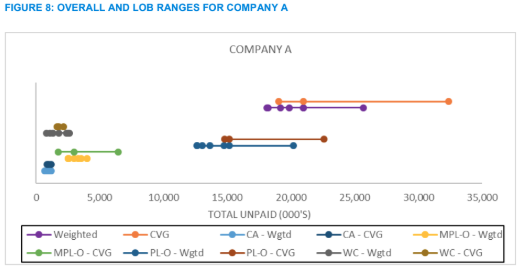
Get Involved
Our authors are what set Insurance Thought Leadership apart.
|
Partner with us
We’d love to talk to you about how we can improve your marketing ROI.
|

Mark Shapland is a senior consultant with the Dubai office of Milliman. He joined the firm in 2003 after 24 years of experience at insurance companies and other consulting firms.
Here are the most-read articles on ITL from 2018.

Given the ferment in the industry this past year, it's no surprise that the most-read of our blog posts concerned leading-edge innovators and some hard-won lessons from innovators. Lemonade, with its genius for stirring the pot, drew the most attention, especially after it called out State Farm for an ad that disparaged some high-tech offerings, including Lemonade's. The main blogs on Lemonade (focusing on the use of chatbots, with some intriguing comments appended) are here:
The most popular of the more instructive pieces, from some of us who have the scars to show for innovation efforts, included:
Among the nearly 600 articles we published at ITL this year, the most read on technology-driven innovation were these:
Because not all issues relate to innovation and not everything is driven by technology, there was, as always, huge readership for Mark Walls' and Kimberly George's scene-setter from last January on the issues that would drive workers' comp this year:
Check it out and see how they did—then get ready, because there will be another early in 2019.
At the risk of overloading you with articles, I am, as always, including links to my six favorite from the past week. And that'll do it for Six Things for this year. I'll continue a mostly regular publishing schedule at the ITL website, and we'll keep sending out alerts on social media, so keep an eye out for anything of interest. We'll then see you back here at Six Things in early January.
I wish you and yours a wonderful Christmas season and a healthy and happy New Year.
Paul Carroll
Editor-in-Chief
Get Involved
Our authors are what set Insurance Thought Leadership apart.
|
Partner with us
We’d love to talk to you about how we can improve your marketing ROI.
|

Paul Carroll is the editor-in-chief of Insurance Thought Leadership.
He is also co-author of A Brief History of a Perfect Future: Inventing the Future We Can Proudly Leave Our Kids by 2050 and Billion Dollar Lessons: What You Can Learn From the Most Inexcusable Business Failures of the Last 25 Years and the author of a best-seller on IBM, published in 1993.
Carroll spent 17 years at the Wall Street Journal as an editor and reporter; he was nominated twice for the Pulitzer Prize. He later was a finalist for a National Magazine Award.
There is a whole lot of not speaking up going on, at a time and in cultures that desperately need the truth.

“I hear you. I really do. I’ve got two stories of my own to share. I also had been told several times by my boss to keep quiet, and not rock the boat. But I saw several errors that I knew would affect the timeline of our project once they were discovered. I took them to my boss who told me under no circumstance was I to say what was going on. When the project got in trouble several months later, the department head, Joe, got involved and asked why I didn’t say anything. I told him I had. He coached me and said that, at times like this, it’s so important to put the project ahead of self-protection. Joe reminded me of what was at stake. And told me I can always come to him as needed. Which I do from time to time–only when absolutely necessary. I still respect the chain of command most of the time. My boss hates it when I go to Joe. But, I know have to do the right thing. Then one day we were in a meeting with Joe. He told us how frustrated he was that people don’t speak up. And then he said, ‘Peter’s the only one.’ When he asked why, everyone just looked at him without saying a word. Then my boss took me aside and said, ‘See, Joe wants you to stop speaking up! Now stop it!’ I was like, ‘What? Were we in the same meeting? And I insisted that we have a three- way conversation with Joe to check for understanding. Joe was unequivocal. ‘I want Peter and everyone on this team to speak up. That’s the only way we will know what’s ever going on.'”Okay, I thought, we’re making real progress in this discussion. But, the truth is, it’s still easier for a guy like Peter to pull this off. And then he began his second story. “About a year ago, I had a peer come to me and tell me she thought I was a bully. I was shocked. I was hurt. I don’t see myself as a bully. I asked why. It came down to the fact that I was holding people accountable, and that was uncomfortable, and I knew I couldn’t change that. But I also knew that accountability is one thing, bullying is another. So I went to some of my other peers. And several of them said, ‘Oh yeah, you’re a bully sometimes.’ And I knew I needed to change. I dug deeper on how my behavior was being perceived. I started listening more. I entered rooms more gently. I watched my tone and manner. No work I’ve ever done on my leadership has made a bigger impact on my influence. I’m still holding people accountable, but I’m watching my style. It’s easier for all of us. Can you imagine if that woman had FOSU? I’d still be frustrating her and everyone else. She did all of us a favor by speaking up. I understand the culture we’re in, but I’ve got to tell you. People don’t speak up enough. We have to talk about this stuff for the culture to change. How can we do that better?'” See also: Voice of the Customer: They’re Not Happy Your Turn: How Can We? And so I turn that question back to you. This is hard, no doubt. But how do we encourage more people to speak up and find their voices? I’d love to hear your stories of overcoming FOSU and the difference it made.
Get Involved
Our authors are what set Insurance Thought Leadership apart.
|
Partner with us
We’d love to talk to you about how we can improve your marketing ROI.
|
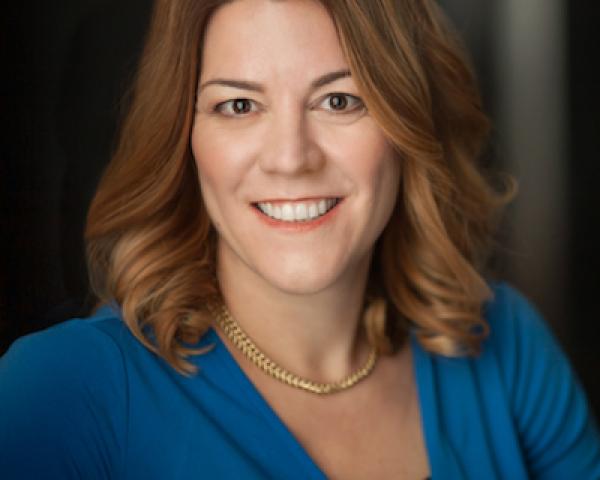
Karin Hurt helps leaders achieve breakthrough results without losing their soul. She is a keynote leadership speaker, a trainer and one of the award-winning authors of Winning Well: A Manager’s Guide to Getting Results Without Losing Your Soul. Hurt is a top leadership consultant and CEO of Let’s Grow Leaders. A former Verizon Wireless executive, she was named to Inc. Magazine’s list of great leadership speakers.
What we traditionally think of as insurance (restoration or loss indemnification) is only one-third of what a new age insurer should be doing.

Get Involved
Our authors are what set Insurance Thought Leadership apart.
|
Partner with us
We’d love to talk to you about how we can improve your marketing ROI.
|

Gaurav leads the Global P&C Insurance practice at Oliver Wyman. With over 30 years of in-depth insurance industry experience as a consultant and practitioner, he delivers high-impact outcomes for large corporations as well as new-age Insurtechs, providing strategic direction at different phases of transformation for growth and profitability. He has demonstrated a strong track record of building successful businesses with sustaining long-term growth trajectories, both organically and inorganically. Prior to Oliver Wyman, Gaurav was an Executive Consultant at Chubb following a progressive career at AIG. As CEO of Global Personal Insurance at AIG, Gaurav was responsible for the global consumer P&C businesses.